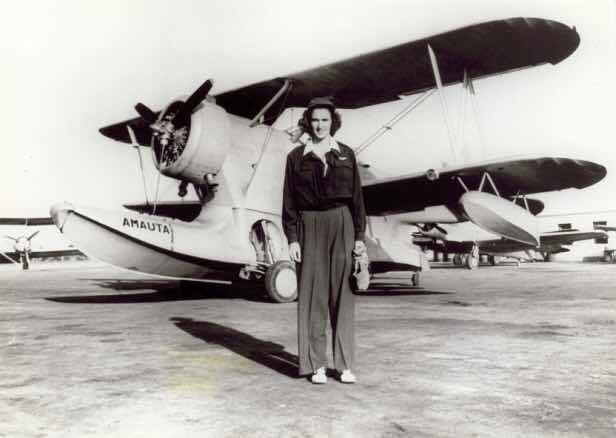
When Betty was 16 years old (during the Great Depression), her uncle gave her and her twin brother, Bill, $100. Bill saved his for college, but Betty used hers to take flying lessons. She’d always had a love for flying and had looked up to people like Charles Lindbergh and Emilia Earhart. She had no idea how she’d ever combine her love for flying and her love for missions, but her friend, Mrs. Bowen asked her, “Do you think God might have given you both of these interests for a reason? Perhaps you should think of combining them and use flying for some Christian Missions work.” It was exactly what Betty needed to hear and she stayed focused on that goal from that day forward.
World War II broke out and Betty wanted to use her gift of flying to help her nation. She joined the Women’s Flying Training Detachment which was later to become known as the WASPs. The women flew military aircraft to different bases so the men would have them at their disposal and ready for battle missions. Women were not allowed to fly in combat. The women were not enlisted and could leave at any time—but Betty stayed until the organization was disbanded. The women were treated as if they were military, but in fact, they were required to pay for their own uniforms, goggles, parachutes, caps, jackets, and room and board. Betty was one of the first people (much less, women) to be involved in the altitude experiments. Pilots had never flown high enough to need oxygen and these experiments were to see the effects of flying at such an altitude.
While Betty was enlisted in the WASPs, she wrote an article for a Christian magazine outlining how she’d like to use her gift of flying with mission work. She had a dream of transporting missionaries in mountainous regions, saving them days of travel time. She received a letter from Jim Truxton saying that he was one of three men with the same vision. Soon, the WASPs disbanded and Betty and the three men began a ministry of pilots helping missionaries, called Christian Airmen’s Missionary Fellowship (CAMF) which eventually became known as Missian Aviation Fellowship (MAF). After a long start of raising money to buy planes, Betty became MAF’s first pilot to fly a plane—to Mexico. Soon, their ministry expanded and pilots and planes were in many areas, living on the fields with the missionaries and making travel possible.
From the late 1940s until the 1960s, Betty Greene ferried missionaries to some of Mexico's and South America's most out-of-the-way settlements. She also was the first woman to fly over the rugged Andes. Betty also flew throughout New Guinea and Africa, where the Sudanese Parliament had to make allowances for a woman to fly her Cessna 180 in the country. She said, “It took an act of Parliament to allow me to fly in Sudan!” They called her `The Golden Voice of the Sudan' because she was a woman, and of course there weren't any women on the radio waves" between the airplane and the ground.
“These experiences were thrilling,” Betty once remarked humbly, “but in all honestly I did not have any ambition to achieve 'firsts' in flying. My mind was set on doing productive work and any achievements in flying came about incidentally as I carried out my assignments.”
Betty Greene died of Alzheimer's disease, April 10, 1997. A group of women from First Presbyterian Church made a roster and took turns caring for her until her death. One day, with clarity, Betty raised from her bed and asked the woman caring for her, “Do you know God?” Upon the woman’s “yes,” her face lit up and she said, “Isn’t it wonderful?”


No comments:
Post a Comment